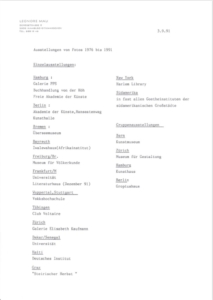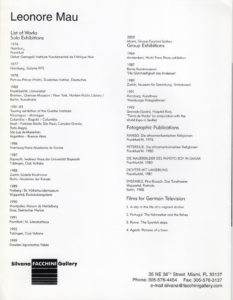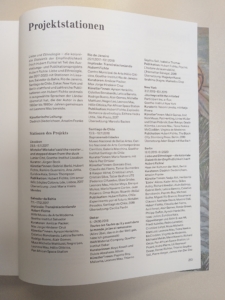Exhibition contexts
The exhibitions of Leonore Mau – Between art and ethnology
Mona Schubert (2021/22)
When they first began working together, the lectures held by her partner Hubert Fichte, as well as later public events related to his posthumous reception, gave Leonore Mau a framework for presenting the photographs she took during their journeys together – as, for example, at the Frankfurt Frobenius Society in 1977, which even today is still one of the leading institutions of ethnology; or as part of the literature symposium Fremde. In Memoriam Hubert Fichte (1935–1986), organised by the Graz art festival Steirischer Herbst in 1990. In turn, Fichte gave readings on the opening nights of Mau’s exhibitions – for instance, at the PPS-Galerie in Hamburg in 1977. Even after his death in 1986, his texts were repeatedly incorporated as central display elements within Mau’s exhibitions – as at the Museum of Ethnology in Leipzig in 2002, or at the Soziokulturelles Zentrum Sudhaus in Tübingen in 2016. Accordingly, Leonore Mau’s and Hubert Fichte’s work was closely intertwined not only in the intense exchange underlying their joint publications, but also in the context of their various lecture and exhibition projects.
Detailed research has revealed that Leonore Mau explored possibilities of organising exhibitions in Senegal and within the African diaspora. Consequently, exhibitions were held at the Institut Fondamental de l’Afrique Noir (IFAN) in Dakar in 1976 and 1980, a further one in 1978 at the German Institute in Port-au-Prince in Haiti, and another at the Countee Cullen Branch Library/Harlem Public Library in New York in 1980. In these shows, the photographs that were exhibited the most since the late 1970s came from one photo book published in 1976 by S. Fischer Verlag, Xango. Die afroamerikanischen Religionen. Images from this book were later shown in all major ethnological collections in Germany, among them in Hanover (1993), Dresden (1999) and Leipzig (2002). Several exhibitions likewise situated in ethnological contexts were held within the framework of thematically related festivals such as the first “Festival der Weltkulturen – Horizonte” in 1979, held at the Akademie der Künste in Berlin; or in the context of an ethnological exhibition with a focus on the Caribbean at the Übersee-Museum in Bremen in 1980; or at the Völkerkundemuseum in Freiburg im Breisgau (now called the Museum für Natur und Mensch) as part of the programme accompanying the Freiburg Film Forum in 1989.
Leonore Mau also published two photographic editions in collaboration with the galleries representing her and S. Fischer Verlag, in other words two portfolios of photographs that have been in circulation, especially art exhibition circuit, since the early 2000s. The first was Grosse Anatomie in 1977, published by the Hamburg-based PPS-Galerie on the initiative of the photographer and collector F.C. Gundlach; following that, in 1990, came Priesterinnen, initiated by Galerie Elisabeth Kaufmann in Basel. Both editions, each prefaced with a text by Fichte, were presented in the Kunsthalle Basel in 2002, in the Deichtorhallen Hamburg in 2014 and in the Fotomuseum Winterthur in 2021.
Beside the gallerists Elisabeth Kaufmann and F.C. Gundlach, further important facilitators and supporters of her work were her friends the German choreographer Pina Bausch and her husband, Chilean author Ronald Kay. As a result, Mau twice showed portraits of Bausch’s dance ensemble in Wuppertal and in Montpellier. Following Fichte’s death in 1986, Kay in turn became editor of Fichte’s publications and supported Mau in her exhibitions. These and other collaborations are also evidence of Leonore Mau’s participation in literary and artistic circles, as well as left-wing and alternative milieus in the German-speaking world. She was also involved in the Freie Akademie der Künste, an artists’ association in Hamburg, from the late 1980s onwards and in the Club Voltaire in Tübingen, where over several decades her works were shown – in 1987, 1992 and 2016.
Apart from S. Fischer Verlag, which had been collaborating with Hubert Fichte and Leonore Mau on their photo books since the 1976, the Goethe-Institut should also be cited as an important institutional cooperative partner. The Goethe-Institut first lent support by participating in a touring exhibition of Xango, presenting it in several South American locations between 1982 and 1983. Further cooperations followed in 2001 at the Goethe-Institut in Salvador and in 2017/18 in branches of the Goethe-Institut in Rio de Janeiro and in Salvador. Finally, in the last years of her life and shortly after she died, Leonore Mau was accorded a significant role in her home city, Hamburg, where in the 2010s several panorama exhibitions of her work took place: in the Deichtorhallen in 2005/06 and in 2014, then in the Jenisch Haus in 2016/17. Exhibitions that explored her work in greater depth based on research were held in the years between 2017 and 2020, initiated by the Haus der Kulturen der Welt (HKW) in Berlin, which focused predominantly on the work of Hubert Fichte, and in 2020 at the Fotomuseum Winterthur, where the focus was directed more on Leonore Mau.
Whereas the contexts regarding the publication of Leonore Mau’s photographs had already been appraised in 2002 by the curator Hinrich Sachs in conjunction with an edition for the Kunsthalle Zurich, a corresponding study concerning the artist’s exhibitions was still to be undertaken. In 2020/2021, thanks to the cooperation between the S. Fischer Foundation and the Fotomuseum Winterthur, it was finally possible to comprehensively fill this gap in research.
Acknowledgement
For their advice, research and our exchange I wish to warmly thank Dulcie Abrahams Altass, Nina Bingel, Marlene Burmeister, Bianca Bozzeda, Regina Bühlmann, Nathalie David, Claus Deimel, Silvia Dolz, Carmen Domínguez, Sebastian Dressel, Anita Eylmann, Maria Fiedler, Hartmut Fischer, Julian Fuchs, Doris Gassert, Heike Gerlach, Anna Götte, Nadine Gruner, Andrea Hadem, Sabine Hohnholz, Sonja Janßen, Tim Kirchner, Alexandra Kuhnke, Franziska Mecklenburg, Dominik Nürenberg, Margit Tabel-Gerster, Hinrich Sachs, Alexandre Santos, the Schomburg Center, Thomas Seelig, Silke Seybold, Gereon Sievernich, Mareike Späth, Peter Steigerwald, Urs Stahel, Jörg Wenzel, Isabel Waquil and Maike Zeidler.
Leonore Mau, Photo exhibitions
1976 until 1991, 03.09.1991
© S. Fischer Stiftung / Nachlass Leonore Mau
Accompanying brochure of the exhibition Living Gods.
Photographs from West Africa and the Americas,
1970-1985, Silvana Facchini Gallery, Miami 2000.
Catalogue of the HKW-Exhibition Love
and Ethnology. The Colonial Dialectic
of Sensitivity (after Hubert Fichte),
Berlin: Sternberg Press 2019, S. 213.
© Marlene Burmeister





